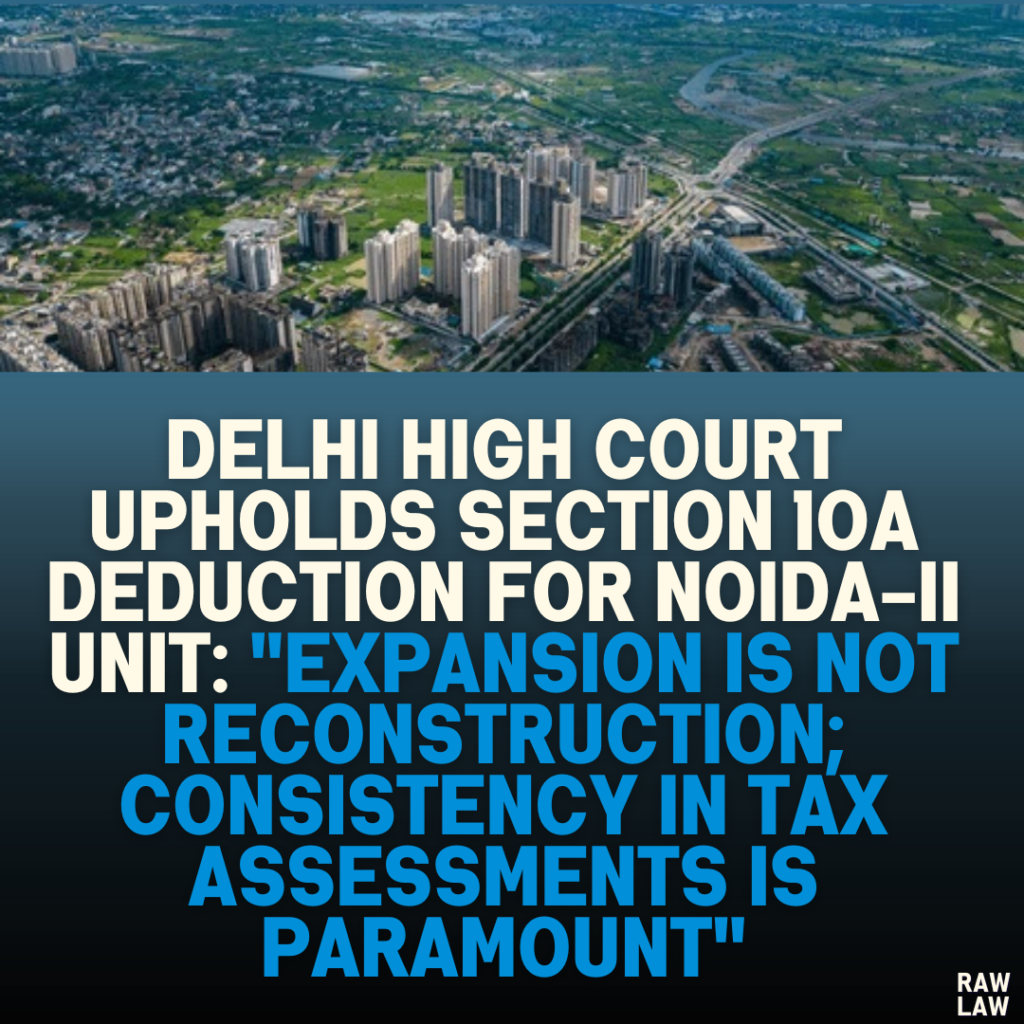Court’s Decision:
The Delhi High Court affirmed the Income Tax Appellate Tribunal (ITAT)’s decision that the NOIDA-II unit of the assessee was eligible for deduction under Section 10A of the Income Tax Act, 1961. The court dismissed the Revenue’s appeal, holding that the NOIDA-II unit was a distinct and new undertaking, not formed by splitting up or reconstruction of an existing business. It emphasized the principle of consistency in tax assessments, stating that previously settled issues should not be reopened without new material facts.
Facts of the Case:
- The Assessee’s Business Operations:
- The assessee is engaged in software development through multiple units, including NOIDA-I and NOIDA-II, both registered under the Software Technology Park Scheme.
- NOIDA-II was established in 2001 on the third floor of the same building as NOIDA-I. It involved substantial investment, increasing the overall capacity from 300 to 700 seats.
- Claim Under Section 10A:
- The assessee claimed deductions for NOIDA-II under Section 10A for export income, asserting that it was a separate and independent unit.
- Initially, the deduction was allowed, but the Assessing Officer (AO) later disallowed it, alleging that NOIDA-II was an extension of NOIDA-I.
- Transfer Pricing Adjustment:
- The AO also referred the case to the Transfer Pricing Officer (TPO), who made adjustments at the unit level rather than at the entity level, leading to further disputes.
Issues Before the Court:
- Whether the NOIDA-II unit was a new undertaking eligible for deductions under Section 10A.
- Whether the denial of deductions violated the principles of consistency in tax assessments.
- Whether the TPO’s approach to transfer pricing adjustments should be at the unit level or entity level.
Petitioner’s (Revenue) Arguments:
- Reconstruction Claim:
- The Revenue argued that NOIDA-II was not a new undertaking but an extension of NOIDA-I. Both units operated in the same building and engaged in similar business activities, thus disqualifying NOIDA-II from Section 10A benefits.
- Transfer Pricing:
- The Revenue contended that transfer pricing adjustments should be conducted at the unit level, as each unit was treated separately for tax benefits.
- Risk of Manipulation:
- The Revenue expressed concerns about potential tax arbitrage, where the assessee could shift profits from non-deductible units to those eligible under Section 10A.
Respondent’s (Assessee) Arguments:
- Independent Unit:
- The assessee emphasized that NOIDA-II was a new and distinct unit, established with fresh capital and infrastructure. It operated independently, catering primarily to a specific client, GE.
- Principles of Consistency:
- The assessee argued that since the Revenue had allowed the deduction in earlier years, it should not revisit the issue in subsequent assessments without new material.
- Entity-Level Adjustment:
- The assessee maintained that transfer pricing adjustments should be conducted at the entity level, considering the integrated nature of its business operations.
Analysis of the Law:
Section 10A of the Income Tax Act:
- Eligibility Criteria:
- Section 10A provides deductions for profits derived from export-oriented undertakings.
- The key exclusionary conditions include:
- The undertaking must not be formed by splitting up or reconstruction of an existing business.
- The undertaking must not result from the transfer of previously used machinery or plant.
- Court’s Interpretation:
- Relying on precedents like Textile Machinery Corp. v. CIT, the court clarified that a new unit can be eligible for deduction even if it operates in the same line of business as the existing unit, provided it is independent and viable.
Consistency in Tax Assessments:
- Citing Radhasoami Satsang v. CIT, the court emphasized that settled issues should not be reopened without new evidence, as it undermines predictability and efficiency in taxation.
Transfer Pricing:
- Arm’s Length Principle:
- Section 92 mandates that income from international transactions with associated enterprises must reflect the arm’s length price (ALP).
- Rule 10B allows the use of the Transactional Net Margin Method (TNMM) for benchmarking, which computes profits at the entity level if operations are interdependent.
- Court’s Finding:
- The court supported the ITAT’s view that adjustments should be at the entity level, as the assessee’s operations had a unified management structure and interlinked business activities.
Precedent Analysis:
- Textile Machinery Corp. v. CIT:
- The Supreme Court held that a new unit, even if part of an existing business, qualifies for tax benefits if it is independent and viable.
- Radhasoami Satsang v. CIT:
- The principle of consistency requires that settled tax positions not be disturbed without significant new evidence.
- CIT v. Yokogawa India Ltd.:
- Section 10A deductions apply to individual undertakings, not the assessee as a whole.
Court’s Reasoning:
- NOIDA-II as a New Undertaking:
- The court found that NOIDA-II had independent operations, significant fresh investments, and no material overlap with NOIDA-I beyond being in the same building.
- The increase in capacity and revenue further supported its independent status.
- Consistency:
- Since the deduction had been allowed in earlier years, the Revenue could not deny it without new evidence.
- Transfer Pricing:
- The unified nature of the assessee’s operations justified entity-level benchmarking.
Conclusion:
The court upheld the ITAT’s findings, ruling in favor of the assessee on all issues. It reaffirmed that NOIDA-II was eligible for Section 10A deductions, and transfer pricing adjustments should be made at the entity level.
Implications:
- Clarity on Section 10A:
- The judgment reinforces that expansion and reconstruction are distinct, and new units in the same line of business can qualify for deductions.
- Consistency in Taxation:
- The ruling strengthens taxpayers’ rights to predictability in assessments, limiting arbitrary reexaminations.
- Transfer Pricing:
- It clarifies the approach for benchmarking interdependent operations, ensuring fairness in ALP computations.




Pingback: Bombay High Court Quashes Convictions Under Sections 186, 353, and 506(i) IPC: Highlights Procedural Lapses in Framing of Charges and Lack of Evidence to Prove Assault on a Public Servant During Discharge of Duties - Raw Law